Library of Congress's Blog, page 167
December 11, 2013
A Celebration of Mexico: A Revolutionary Film
This Thursday and Friday, the Library of Congress is hosting a special “Celebration of Mexico” to honor the culture and history of Hispanic Americans and highlight the Library’s collection of Hispanic materials, which is the largest in the world.
During the event, the Library will present the world premiere of the oldest-known documentary footage of Mexico. The institution has the only existing copy of the film, “The History of the Mexican Revolution,” a compilation documentary shot by several newsreel cameramen over a span of nearly 30 years. These compilation histories represent the first documentaries in Mexico’s rich cinematic history. The film is part of the Library’s John E. Allen, Inc. Collection, which contains many unique and best-serving copies of American films like WWI- and WWII-era actualities, sound era dramatic fathers, silent films from New York-area studios and the “all-black newsreels” from the 1940s.
In this short video, Mike Mashon, head of the Library’s Moving Image Section, talks about the historical and cultural importance of this film and the Library of Congress Motion Picture Laboratory’s efforts to preserve it.
{
mediaObjectId: 'ECC9BF28596401E2E0438C93F02801E2',
playerSize: 'mediumWide'
}
“A Celebration of Mexico,” a two-day conference and accompanying display at the Library of Congress, will open on December 12, the Day of the Virgin of Guadalupe, a popular national holiday in Mexico. For more information and more videos, visit the website.
December 6, 2013
InRetrospect: November Blogging Edition
The Library of Congress blogosphere was a cornucopia of posts on special holidays and more. Here is just a taste.
In the Muse: Performing Arts Blog
#Britten100: Benjamin Britten & Peter Pears at the Library
November 22 marked the hundredth birthday of British composer Benjamin Britten.
Inside Adams: Science, Technology & Business
Civil War Thanksgiving Foods
Ellen Terrell explores how Civil War soldiers celebrated the holiday.
In Custodia Legis: Law Librarians of Congress
Armistice Day/Veterans Day
Megan Wood discusses the importance of the holiday.
The Signal: Digital Preservation
Ten Tips for Preserving Your Holiday Digital Memories
Mike Ashenfelder offers advice for keeping your holiday memories safe for the future.
Teaching with the Library of Congress
Mark Twain’s “Huckleberry Finn”: Controversy at the Heart of a Classic
The Library’s primary sources can help provoke student thinking regarding the novel’s central issues.
Picture This: Library of Congress Prints & Photos
Sequoyah: A Man of Letters
This Cherokee Indian invented the written form of his spoken language.
From the Catbird Seat: Poetry & Literature at the Library of Congress
A Thanksgiving Poem for Lincoln
Abraham Lincoln receives poems in thanks for his Thanksgiving proclamation.
Folklife Today
Putting Foods By for the Winter
Stephanie Hall talks about food preservation.
Library in the News: November 2013 Edition
Making a splash in the news headlines was the public opening of The Seth MacFarlane Collection of the Carl Sagan and Ann Druyan Archive. The Library of Congress hosted MacFarlane, Druyan, Neil deGrasse Tyson, Bill Nye “The Science Guy” and a host of other scientists and educators during a special event in Nov. 12. Full coverage over the course of a couple days came from a variety of outlets.
“Now billions of people on our “Pale Blue Dot” can take a look at the historical letters, studies, and musings of pioneering space scientist Carl Sagan,” said Dara Kerr of CNET.
Calling MacFarlane a “science geek,” The Washington Post’s Reliable Source column quoted the celebrity expressing concern that “science literacy is fading.”
Sara Ash from MSNBC said, “The program was filled with talk after talk by people who knew Sagan, worked with him, or were mentored by him. Each speaker might have laid out different facts of their interactions with Sagan, but their stories were all the same. He was one of a kind in his ability to talk to people of all ages and backgrounds and inspire in them the desire to know more about where we came from.”
Other outlets that ran stories included the Cornell Chronicle (Sagan was a professor of astronomy at the university), ABC News, Mashable, The Examiner, Roll Call, Mother Jones, Scienceline and space.com.
Also going public in November – on public display that is – was the Library’s Nicolay copy of the Gettysburg Address, which is presumed to be the first draft of the historical document. (The Library also has the presumed second draft.) The exhibit also marked the 150th anniversary of the famous speech.
The Washington Post featured a transcription of the entire speech. The Baltimore Sun featured a picture slideshow, with a variety of images from the Library of Congress, including the Gettysburg Address on display.
Library curator Michelle Krowl spoke with PBS Newshour in commemoration of the address’s anniversary. “What you see is that Lincoln worked on the address in Washington first, and then probably got to Gettysburg and changed his mind about the ending. So you can think about what might have inspired Lincoln to change that ending about a new birth of freedom and a government of the people, by the people and for the people.”
CNN talked about the work that goes into preserving such a document. “To protect their two copies of the Gettysburg Address, preservationists there [Library of Congress] fabricated custom cases with gaskets that purge all of the oxygen around the document and replace it with inert argon gas. When you take away the oxygen, you take away the potential of oxidation, which can erode the delicate original material.”
Countless other news outlets – broadcast and print, local and national – covered the anniversary and referenced the Library’s copies of the address.
Other preservation efforts of the Library include maintaining the largest comic-book collection in the United States, with more than 11,000 titles and over 130,000 single issues. David Dissanayake of bleedingcool.com came to the Library to talk with the curators of the collection and check out some of its most treasured items.
“Knowing that there is an institution collecting and preserving comics for future generations puts my mind at ease. … Preserving comics is such an important undertaking, not only for comics as a medium, but for our culture and for history itself.”
Speaking of preserving items of historical value, the Library in November announced a collaboration with WGBH Boston to preserve a collection of American public radio and television content, dating back through the 1950s.
It was covered by was the Associated Press, the Huffington Post, Broadcasting & Cable and The Boston Globe.
Finally, an article poking a little fun at today’s “selfie” (self-portrait), highlighted an interesting find at the Library.
“Although its current rampant incarnation is quite recent, the ‘selfie’ is far from being a strictly modern phenomenon,” wrote The Public Domain Review. “In fact, the picture considered by many to be the first photographic portrait ever taken was a ‘selfie.’ The image in question was taken in 1839 by an amateur chemist and photography enthusiast from Philadelphia named Robert Cornelius.”
(The “selfie” in question is part of the Library’s historical photograph collections.)
Picking up the story were websites Neatorama, Open Culture, i09 and Fast Company.
December 5, 2013
A Temperate Nation
Today marks the 80th anniversary of the end of Prohibition. On Dec. 5, 1933, the United States repealed the nationwide prohibition on alcoholic beverages, by ratifying the 21st Amendment to the U.S. Constitution. And, while the masses may have raised their glasses, there were certainly those among them not happy with the decision. Temperance activists championed Prohibition because they felt alcohol was a social ill.
 Kansas became the first state to outlaw alcohol, in its constitution, in 1881. Enter Carrie Nation – talk about someone you’d want on your team in a bar brawl. Nation was a hatchet-wielding, 6-foot tall, 175-pound weapon of mass destruction who left the dust and rubble of early 20th-century saloons in her wake. A staunch supporter of the temperance movement, Nation was arrested some 30 times for her position against alcohol. Talk about an axe to grind!
Kansas became the first state to outlaw alcohol, in its constitution, in 1881. Enter Carrie Nation – talk about someone you’d want on your team in a bar brawl. Nation was a hatchet-wielding, 6-foot tall, 175-pound weapon of mass destruction who left the dust and rubble of early 20th-century saloons in her wake. A staunch supporter of the temperance movement, Nation was arrested some 30 times for her position against alcohol. Talk about an axe to grind!
On Dec. 27, 1900, Nation brought her campaign to Wichita, Kan., where she smashed the bar at the Carey Hotel. This first public demonstration kicked off her harangue on hooch, which continued for 10 years. But her public protests didn’t stop there … Nation stood on her soapbox against foreign goods, corsets, tobacco, fraternal orders and, most importantly, short skirts. According to the Kansas State Historical Society, as her anti-alcohol activities became widely known, many barrooms adopted the slogan “All Nations Welcome But Carrie.”
Nation died in 1911, before Prohibition became a national law with the enactment of the 18th Amendment in January 1920. A story on her death in the Lincoln County Leader, Sept. 1, 1911, carried a sub-headline that read “Saloon Smashing Made Her Famous – She Realized a Fortune Hatchets.” (Apparently she made a good deal of money selling souvenir hatchets.)
“During her career Mrs. Nation wrecked hundreds of saloons, using a hatchet, which became as well known as she. She was absolutely with out fear, invading saloons, demolishing mirrors and furniture and assailing bartenders and proprietors without re gard for her own safety. She had many narrow escapes from injury and was roughly handled on several occasions.”
December 4, 2013
A Celebration of Mexico: A Champion of Reform
The Library of Congress has the largest collection of Hispanic materials in the world, including rare items of Mexican origin. Next Thursday and Friday, the institution is hosting a special “Celebration of Mexico” to take a look at some of these items and to also honor Hispanic and Mexican heritage. As part of the celebration, several of the institution’s curators have highlighted a few of the Library’s most treasured artifacts in a series of brief webcasts.
Bartolomé de Las Casas is known throughout history for his stand on the rights of native Americans. The Library holds several of his writings in his collections, including this book to inform the Spanish Crown that officials and landowners in the New World were behaving cruelly toward their indigenous subjects and to plead for redress. His book had an enormous impact, prompting Emperor Charles V to recognize the humanity of indigenous peoples and to issue the New Laws of the Indies in 1542, ending the absolute power of individual Spaniards.
Library of Congress Hispanic Division specialist Barbara Tenenbaum shares insights into the history of the early Americas and Dominican priest and social reformer Bartolomé de las Casas.
{
mediaObjectId: 'EB25401BA8390108E0438C93F0280108',
playerSize: 'mediumWide'
}
“A Celebration of Mexico,” a two-day conference and accompanying display at the Library of Congress, will open on December 12, the Day of the Virgin of Guadalupe, a popular national holiday in Mexico. For more information and more videos, visit the website.
November 27, 2013
A Thankful Proclamation
 Earlier this month, a few news outlets ran a story about a rare document signed by George Washington up for auction at Christie’s. According to a Christie’s spokesperson, the item in question had the potential to fetch $8 to $12 million, potentially setting a record for the most expensive American manuscript ever sold at auction. No one bought the document, but that doesn’t mean its historical value is destined to be lost.
Earlier this month, a few news outlets ran a story about a rare document signed by George Washington up for auction at Christie’s. According to a Christie’s spokesperson, the item in question had the potential to fetch $8 to $12 million, potentially setting a record for the most expensive American manuscript ever sold at auction. No one bought the document, but that doesn’t mean its historical value is destined to be lost.
The document is one of two known surviving copies – and the Library of Congress has the other. What makes this article so valuable and significant? The document is a proclamation establishing the first federal Thanksgiving Day!
The proclamation, signed by the first U.S. president on Oct. 3, 1789, in New York states: “both Houses of Congress have by their joint Committee requested me to recommend to the People of the United States a day of public thanksgiving and prayer …”
You can read the full transcription here.
The Library of Congress is home to the papers of George Washington.
November 25, 2013
Conservation Corner: Housing Carl Sagan Whiteboard
The Library of Congress has one of the most extensive preservation programs for library materials in the world. Each year the Library’s preservation staff provides preservation treatment for countless objects in its collection of more than 155 million items.
The Conservation Division cares for the Library’s special collections, including rare books and manuscripts, works of art and other unique documents on paper, photographs, maps, objects, and other special formats. The division also monitors storage and exhibition environments, stabilizes materials for optimized storage, exhibition, and digitization, and manages the Library’s collections emergency team.
From time to time, we’ll take a look at the important work being done by the Library’s Preservation Directorate, [link] whose work ensures long-term, uninterrupted access to the intellectual content of the Library’s collections.
(The following is a guest post by Nancy Lev-Alexander, head of the Collections Stabilization Section in the Conservation Division.)
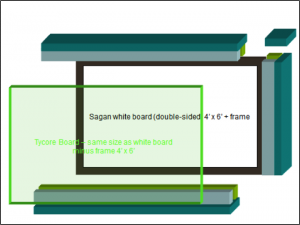 The Conservation Division staff recently designed and fabricated a custom-made protective cover for the 4’ x 6’ whiteboard that documents the collaboration of Carl Sagan with his wife Ann Druyan for the movie “Contact,” which premiered in 1997. The whiteboard is by far the largest of the wide variety of materials in the Seth MacFarlane Collection of the Carl Sagan and Ann Druyan Archive. This archival collection includes Sagan and Druyan’s treatment for the movie in 1980, transcripts of story and script meetings in 1994, various versions of the film script from 1993-1997, and discussions of the artwork and graphics for the film.
The Conservation Division staff recently designed and fabricated a custom-made protective cover for the 4’ x 6’ whiteboard that documents the collaboration of Carl Sagan with his wife Ann Druyan for the movie “Contact,” which premiered in 1997. The whiteboard is by far the largest of the wide variety of materials in the Seth MacFarlane Collection of the Carl Sagan and Ann Druyan Archive. This archival collection includes Sagan and Druyan’s treatment for the movie in 1980, transcripts of story and script meetings in 1994, various versions of the film script from 1993-1997, and discussions of the artwork and graphics for the film.
The whiteboard presented multiple preservation challenges due to the size of the object, the need to reveal both sides of the board, and the need to avoid wiping or disruption of the writing displayed on the board. To address these requirements, Preservation Specialist Jennifer Lewis first prepared the schematic drawing seen here, along with several small test cross-sections of the construction before working on the final housing.
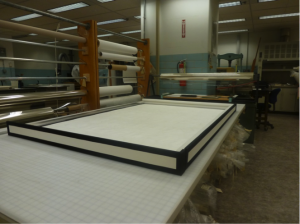
The storage box during construction showing internal foam channels. / Photo by Jennifer Lewis
Lewis designed and fabricated the enclosure to provide full protection from light exposure, dust or accidental contact. To construct a strong but lightweight construction, Lewis used lightweight corrugated board. To create an internal surface that would prevent abrasion of the written surface, she covered the board in Tyvek, a synthetic, protective wrap. Heavier book covering cloth was used to protect board edges, and foam channels were added to secure and support the whiteboard inside the box.
The protective enclosure features removable panels that provide access to both sides of the whiteboard and are easily re-secured using a series of heavy straps and Velcro closures. All materials including board, foam, cloths and adhesives, were carefully selected to ensure their chemical stability, durability and practicality for use in such large-format construction due to the size and expense of the materials required.
Enclosure under construction in Conservation Division
The box was completed and delivered in time for the “Celebration of Carl Sagan” event held on Nov. 12, which marked the official opening to the public [link] of the Seth MacFarlane Collection of the Carl Sagan and Ann Druyan Archive. The whiteboard was placed into its protective box and strapped upright in the Manuscript Division, [link ]where it will be permanently stored.
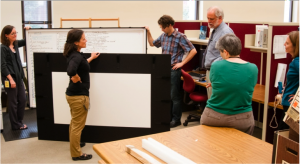
Conservation Division and Manuscript Division staff review white board placed in completed protective housing. / Photo by Richard Hebert
November 22, 2013
The Sound of Drums
On Friday, November 22, 1963, the students in Mrs. Maxwell’s third-grade class at Sabin Elementary School in southwest Denver got a singular history lesson: the news came in that President John F. Kennedy had been murdered.
Janet Maxwell, a popular young instructor who taught 25 kids reading, math, science and history by turns, was trying to get an educational program on a radio at the front of the classroom – a weekly radio play called “I Am an American” in which actors dramatized the lives of famous figures in U.S. history. But she couldn’t seem to lock in the station. So she went next door to Mrs. Grossman’s room to see if they were having difficulty there, as well.
When she came back, perhaps 10 minutes later, her students – I was one of them — were startled to find her weeping.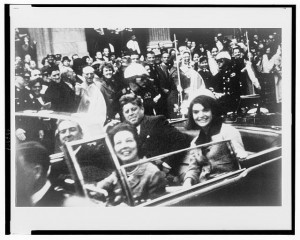
“Boys and girls, I don’t know how to tell you this,” she said. “President Kennedy has been shot. I hope he will be all right.”
We were stunned. A couple of kids began crying, too. We were old enough to understand that the leader of our country was fighting for his life, and might even be dead. The president! The president of the United States.
This was not an era of instant communication. There might have been one TV in the whole school. But we did have the radio in the classroom, and Mrs. Maxwell began dialing around to find news coverage of the shooting.
It was only a matter of minutes before the announcement came: President Kennedy was dead.
Mrs. Maxwell tried to project an air of calm, but her grief could not be hidden, and it upset all of us.
Lunchtime came, and we took our sack lunches and went out on the gravel field beside the school. Some kids were hysterical. Other kids were silent, a little frightened by the effect this news had on adults. I wondered what my Mom and Dad were thinking. I knew they liked President Kennedy and had voted for him.
We tried to have a normal afternoon in school, but no one could keep their mind on the work. One boy cracked an inappropriate joke; Mrs. Maxwell upbraided him. At 3:20 we got to go home.
That night I went to my friend Jonnie Sue’s house for a sleepover. My mother urged me to have fun and not to dwell too much on the sad event.
But all Jonnie Sue and I did Saturday morning, when we would ordinarily have been watching cartoons, was to stay glued to the wall-to-wall television coverage of the assassination, the swearing-in of LBJ, the speculation about the arrested man, Lee Harvey Oswald. I walked home at noon and a few hours were spent away from the TV.
Sunday morning I got up and went to the basement, where we had a big black-and-white tube set. As I sat there in my pajamas, police officers were seen moving Lee Harvey Oswald along a corridor crowded with people. A man—later identified as Jack Ruby — stepped forward, and suddenly Oswald’s face contorted in pain. He had been shot, right there on live TV, and I had witnessed it as it happened.
I ran upstairs, delivering my first “flash” in a lifetime that later included 18 years as a newspaperwoman: “Dad! Dad! Somebody shot Lee Harvey Oswald!”
The true tragedy came through to me as I watched the state funeral Monday on TV. JFK’s children stood by their mother as their father’s casket rolled past. I was only a little older than those kids. The roll of the drums was unforgettable:
Brum – brum – brum – brrrr
Brum – brum – brum – brrrr
Brum – brum – brum – brrrr
Brum
Brum – ba – brum.
It may be hard for people born more recently to grasp the impact John F. Kennedy had on lives in that era. In later years I met several people who had been inspired by his challenge to “Ask not what your country can do for you, but what you can do for your country” and in response had actually joined the Peace Corps or done some kind of public service. Kennedy’s killing did great damage to their collective spirit.
Within five years, both Bobby Kennedy and Martin Luther King were dead at the hands of assassins. It was a profoundly disquieting time.
But this is America. New leaders step forward, and we build the bench so new leaders can step forward. Democracy can be untidy, and not always satisfying, but it still beats the alternatives.
Who will fill out that bench – by serving on the city council, or the school board, or in the legislature?
What can you do for your country?
November 21, 2013
A Celebration of Mexico: Honoring a “Living Legend”
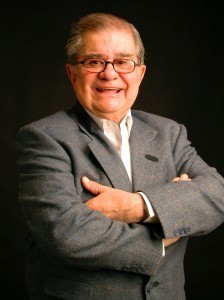
Miguel León-Portilla
Mexican anthropologist and historian Miguel León-Portilla is the newest recipient of the Library of Congress Living Legend Award for his work in studying the Náhuatl language and literature – the ancient, still-spoken tongue of the Aztecs. The award will be conferred upon León-Portill at the Library’s “Celebration of Mexico”on Dec. 12.
The Living Legend Award honors those who have made significant contributions to America’s diverse cultural, scientific and social heritage. León-Portilla is the world’s foremost authority on Náhuatl philology and philosophy. He has spearheaded an entire scholarly discipline to evaluate and understand Náhuatl literature and thought, extending from pre-Columbian times to the 1.5 million speakers of Náhuatl today. The language of the Aztecs, Náhuatl has been spoken in Central Mexico since at least the 7th century AD.
León-Portilla discusses his work in a set of podcasts, both in English and Spanish.
Subscribe to other podcasts and listen to interviews with select conference participants in advance of the celebratory event, including novelist/poet Carmen Boullosa and author Sandra Cisneros.
The first Living Legend awards were given in 2000 during the Library’s bicentennial (1800-2000) celebration. Recipients through the years have included artists, writers, filmmakers, physicians, entertainers, sports figures, public servants and musicians who have enriched the nation through their professional accomplishments and personal excellence. Madeleine Albright, Katharine Graham, B.B. King, David McCullough, Gordon Parks, Alan Lomax, I.M. Pei, Sally Ride, Martin Scorsese, Yo Yo Ma, Bill Cosby and Mario Andretti are among the more than 100 recipients.
“A Celebration of Mexico,” a two-day conference and accompanying display at the Library of Congress, will open on December 12, the Day of the Virgin of Guadalupe, a popular national holiday in Mexico. For more information, visit the website.
November 20, 2013
You’ve Heard The Phrase “100-Year Storm?”
As the world turns its sympathy toward the Philippine islands devastated, just days ago, by the largest typhoon in recorded history, a fascinating fact has emerged and moved explosively across the Internet:
Just over a century ago, those same islands – indeed that same nearly destroyed town on the island of Leyte, Tacloban – were raked by another death-dealing typhoon that was estimated to have killed 15,000.
How was this fact verified? By reference sources available right on the web, housed here at the Library of Congress on a site known as “Chronicling America.” The site offers hundreds of old newspapers, online, and is searchable. It’s a joint project of the Library and the National Endowment for the Humanities. Activity on that site (especially from mobile devices) suddenly spiked starting two days ago – it was five or six times the traffic of a normal day — and when our web analysts looked into it, they found typhoon links and a big upsurge in traffic from users in the Philippines underpinning that.
Here’s the link that went viral.
It’s a shame that it takes a tragedy – make that two tragedies – to bring this excellent research tool into focus. And, while this is indeed a sad story, looking at old newspapers isn’t exactly drudgery – you may notice, while doing research in old papers, how easy it is to be distracted by the highly opinionated writing, the ads for everything from corsets to cure-all medicines and the odd, sometimes ridiculous illustrations. If you’re not careful, you’ll never get that research done!
The suffering denizens of Leyte will include no one who can remember their past as far back as 1912; sadly, they were condemned to repeat it. But there’s a glimmer of hope in this history as well – Tacloban made a comeback after that horrifying storm 100 years ago. Presumably it can again.
Library of Congress's Blog
- Library of Congress's profile
- 74 followers




